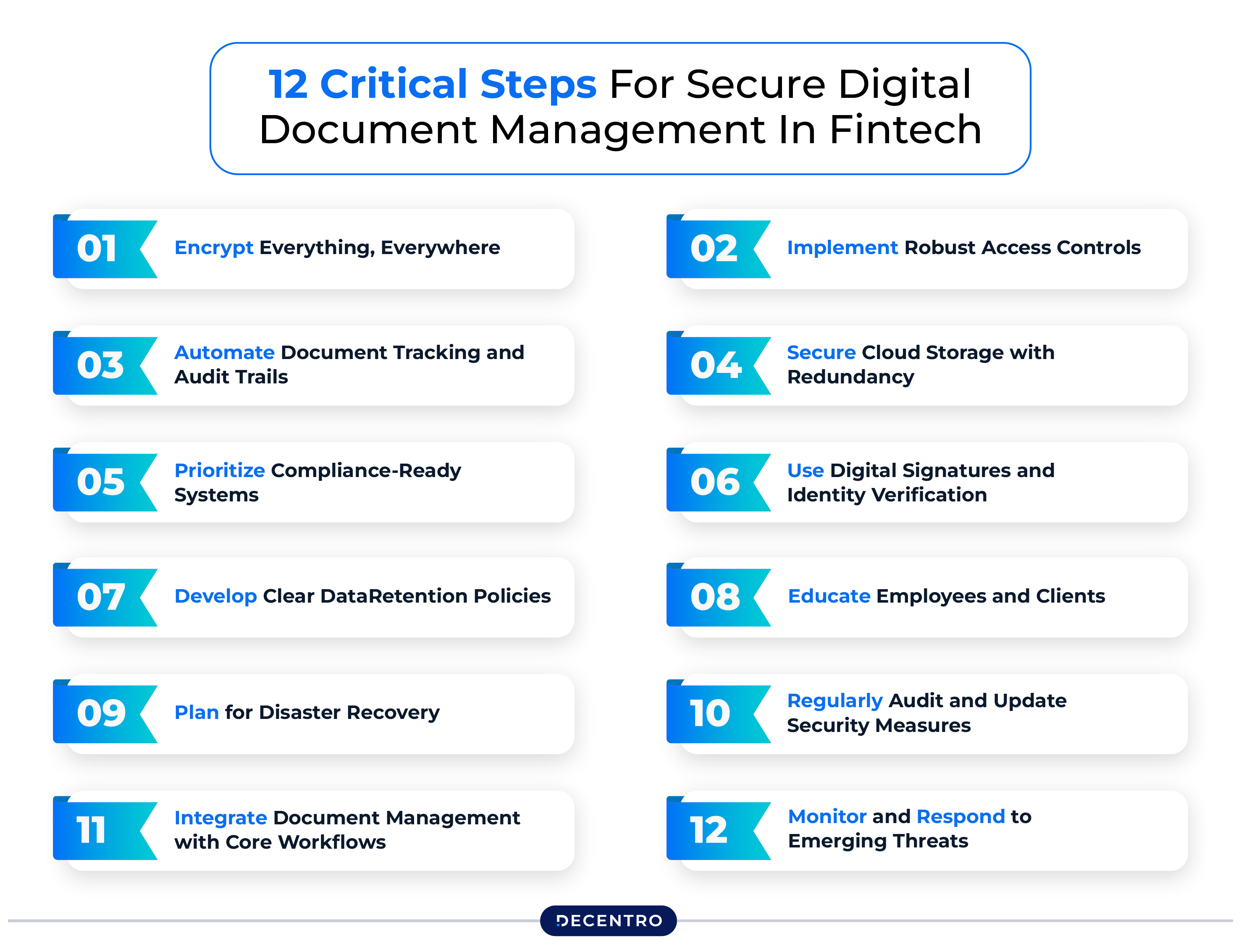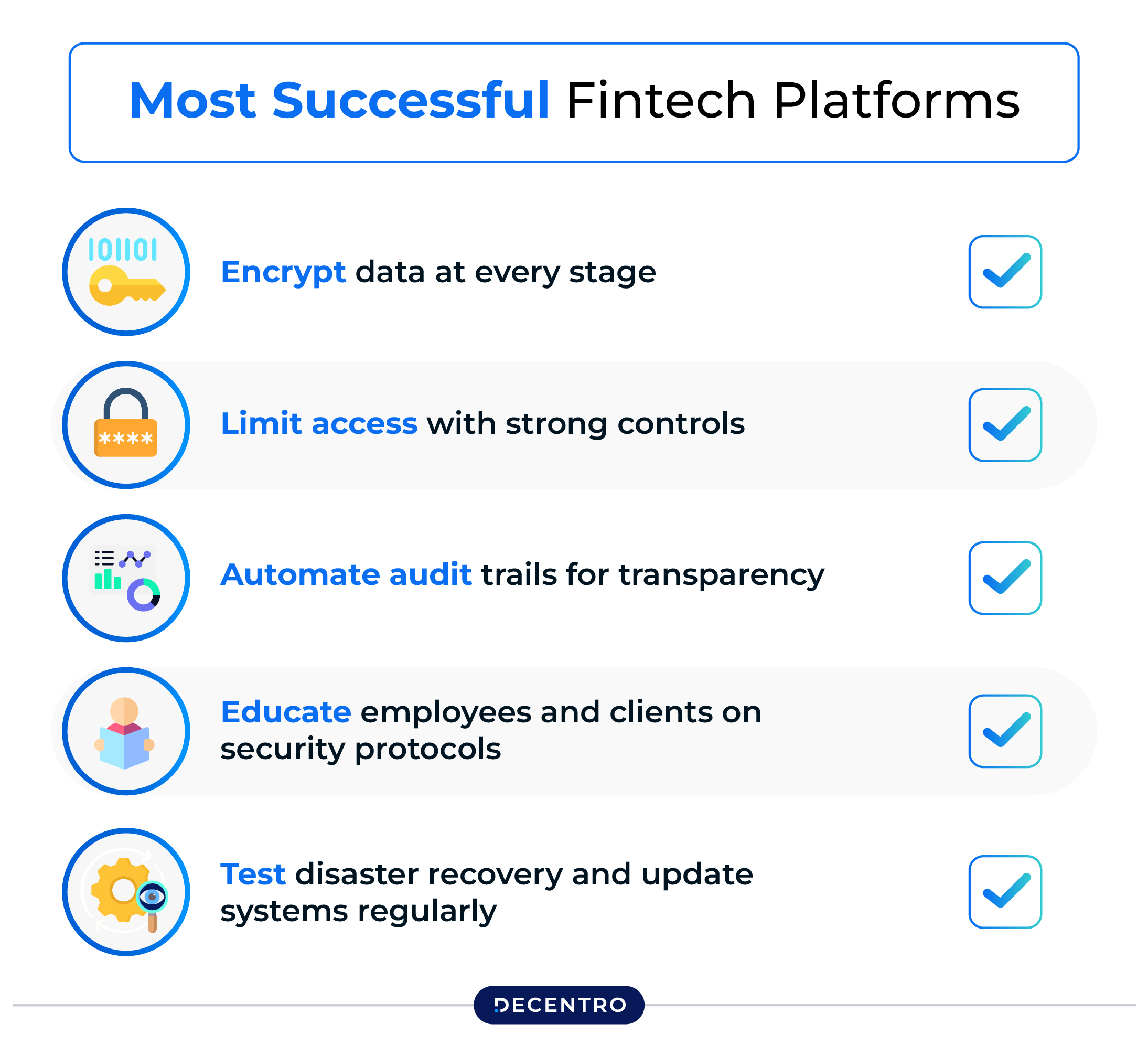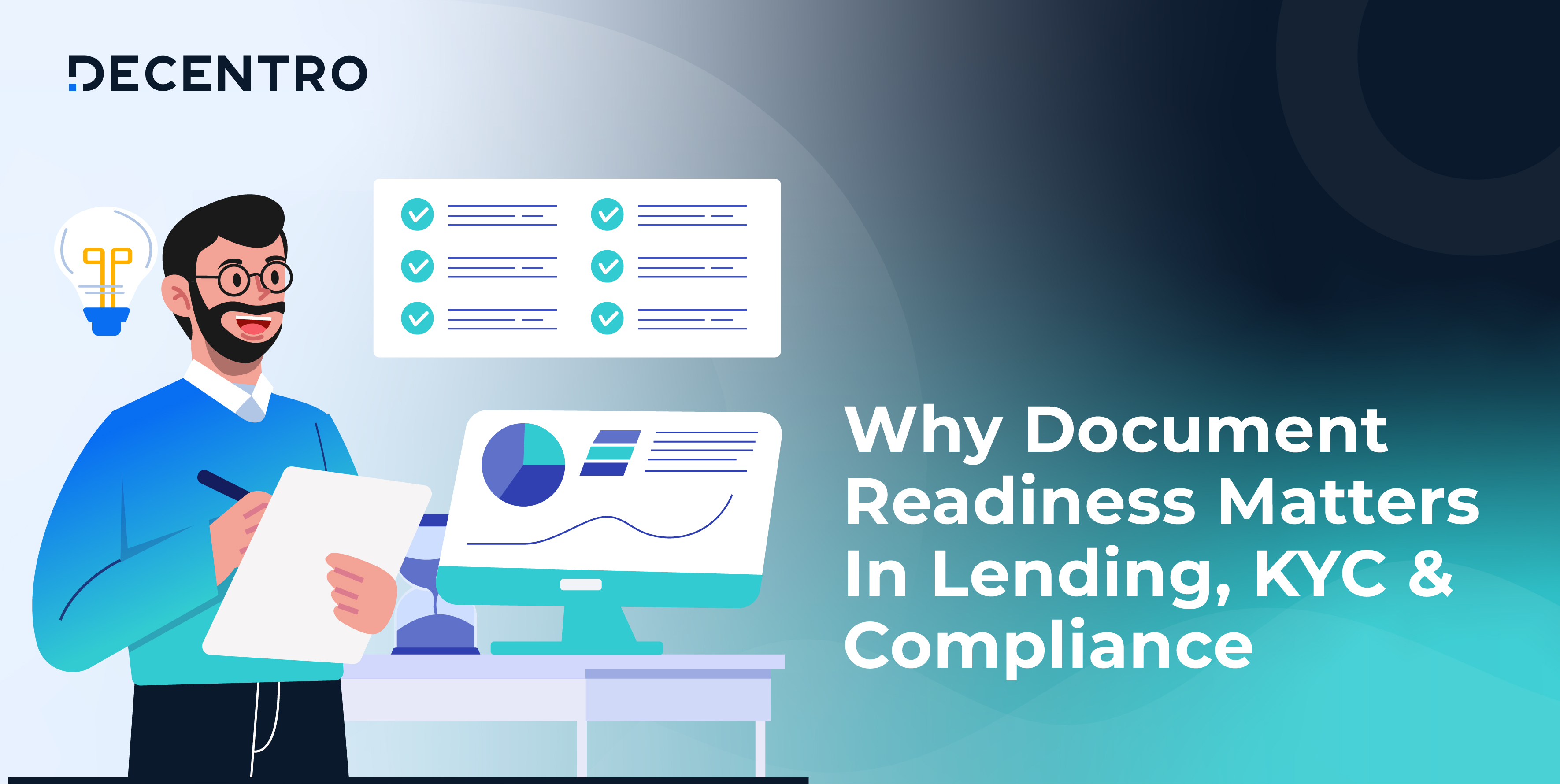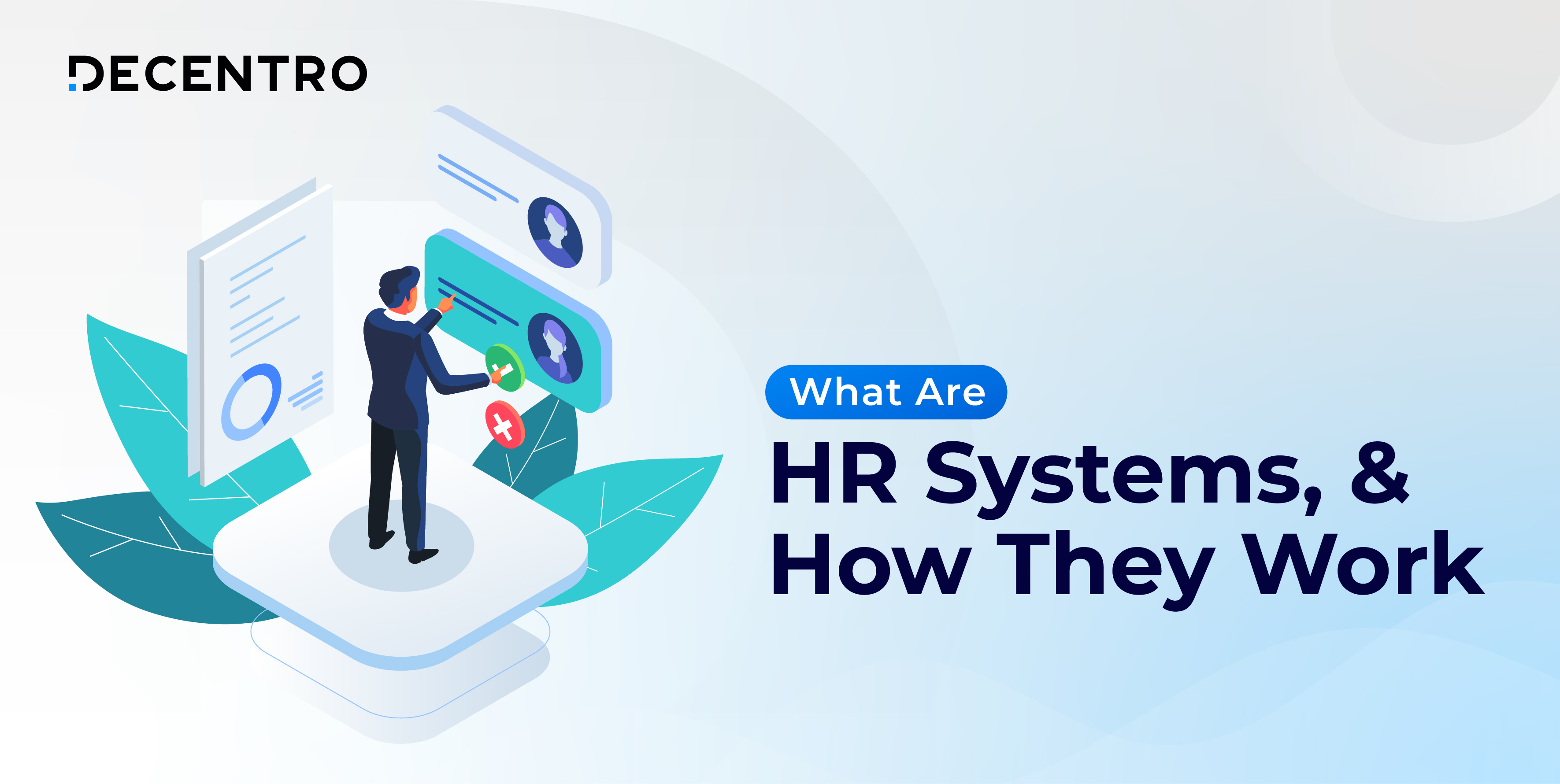From encryption to audits, explore 12 steps for secure digital document management in fintech. Safeguard sensitive data with confidence.

12 Critical Steps For Secure Digital Document Management In Fintech
A true blue millennial trying to engineer her full time-career around the world of content. How cliché is that?
Table of Contents

The fintech industry thrives on speed, precision, and trust. Every digital document, from loan applications to payroll records, contains sensitive data that must be managed carefully. A single misstep in handling financial documents can lead to compliance issues, reputational damage, or worse, a costly security breach.
For companies working in payroll, lending, or brokerage services, secure digital document management is more than a convenience. It is the backbone of regulatory compliance and customer trust. To stay competitive, fintech platforms need a clear strategy for securing, storing, and transmitting digital financial records.
Let’s dive into some of the top 12 steps fintech companies can take to ensure secure digital document management.
Why Document Security Matters in Fintech

Unlike other industries, fintech deals with documents that are both financial and personal in nature. Tax records, stock trade confirmations, loan agreements, and payroll details are all prime targets for fraud or identity theft.
A practical example is payroll management. Businesses must securely transmit tax forms such as the W-2, which contain employee earnings and identification details.
Resources that make it easier to create W-2 for employees while staying compliant show how fintech systems must balance usability with security.
That balance is the foundation for building customer trust and scaling fintech platforms responsibly. With that in mind, here are the most critical steps for secure digital document management in fintech.
Step 1: Encrypt Everything, Everywhere
Encryption is non-negotiable in fintech. Documents must be encrypted when stored on servers and when transmitted across networks. Without it, sensitive files like payroll tax forms, loan contracts, or brokerage trade data are at risk.
For payroll providers, encryption prevents employees’ Social Security numbers and salary data from being exposed during transmission. Lending platforms use encryption to safeguard scanned IDs, income verification records, and credit histories. Brokerage firms rely on it to protect transaction confirmations and portfolio reports.
Key practices include:
- End-to-end encryption for all sensitive documents
- Automated encryption to eliminate human oversight errors
- Routine reviews to ensure standards meet regulatory updates
Step 2: Implement Robust Access Controls
Not every employee should have access to every document. Access should always be based on role and necessity. Payroll clerks may need employee tax forms, while a broker on the trading desk does not.
Lending platforms can segment access so underwriters see only loan files, while customer service agents access only the information required for support. Payroll systems can restrict access to HR managers but prevent finance interns from viewing sensitive wage data.
Effective controls look like this:
- Role-based access control (RBAC)
- Multifactor authentication across devices
- Regular audits of access logs to detect abuse
Step 3: Automate Document Tracking and Audit Trails
Manual tracking leaves too much room for error in fintech. Every financial document should have an automated trail that records when it was created, who accessed it, and what changes were made.
For payroll providers, this helps confirm exactly when a W-2 was generated and which staff member reviewed it. In lending, it ensures that once a loan agreement is uploaded, no edits can occur without leaving a digital footprint. In brokerage firms, audit trails can confirm that a compliance officer reviewed documents tied to specific trades.
Automated audit trails:
- Increase transparency across teams
- Support compliance reporting during audits
- Help resolve disputes quickly with clear evidence
Step 4: Secure Cloud Storage with Redundancy
Cloud storage is standard in fintech, but not all cloud providers meet industry needs. Documents must be stored securely, redundantly, and in compliance with regulations.
Payroll firms risk serious business interruption if storage fails near tax season. Lenders can lose critical borrower records if servers go down without backups. Brokerage firms, which rely on real-time access to confirmations, cannot afford downtime.
When evaluating providers, fintech companies should look for:
- Advanced encryption for stored and transmitted data
- Geographic redundancy across multiple regions
- Certifications like SOC 2, ISO 27001, or FedRAMP
Step 5: Prioritize Compliance-Ready Systems
Fintech operates in one of the most regulated environments. Systems must be designed to meet compliance requirements before a single document is uploaded.
Payroll providers must align with IRS regulations for tax documents. Lenders must comply with the Truth in Lending Act requirements and fair credit reporting standards. Brokerage firms must comply with SEC and FINRA rules regarding the storage and retention of documents.
Building compliance into document management systems prevents penalties and reassures customers that sensitive data is protected. Platforms that can generate compliance-ready reports on demand save significant time and resources during audits.
Step 6: Use Digital Signatures and Identity Verification
Paper signatures no longer meet the speed or security needs of fintech. Digital signature solutions are legally binding and add significant protection.
Lenders use them to finalize loan agreements quickly while verifying the borrower’s identity through multi-step authentication. Payroll providers can validate employee information during onboarding. Brokerage firms can streamline new account openings by verifying IDs electronically.
Services like Decentro’s document scanner can help ensure that sensitive uploads are captured securely, formatted consistently, and checked for compliance. This step eliminates the risk of manual handling while enhancing speed and accuracy.
Best practices include:
- Using compliant digital signature platforms (ESIGN, eIDAS)
- Pairing signatures with identity verification steps
- Storing completed documents in tamper-proof formats
Step 7: Develop Clear Data Retention Policies
Holding documents longer than necessary creates unnecessary risk. Fintech companies must define exactly how long records are stored and when they should be destroyed.
Payroll services may be required to retain tax documents for a period of seven years. Lending institutions may need to store loan agreements for the lifetime of the loan, plus an additional period. Brokerage firms must comply with strict SEC rules regarding the retention of trade records.
Clear retention policies help:
- Reduce liability by avoiding excess storage of sensitive data
- Automate compliance through scheduled deletions
- Keep storage systems efficient and uncluttered
Step 8: Educate Employees and Clients
The strongest systems can still fail if people don’t follow protocols. Both employees and clients must understand best practices for secure document handling.
Payroll staff need regular training on identifying phishing scams that target employee tax forms. Lenders must ensure that underwriters understand the importance of password hygiene when accessing borrower documents. Brokers need to educate clients on uploading sensitive forms only through secure portals, not email.
Education efforts should focus on:
- Spotting phishing and social engineering
- Using strong, unique passwords and multifactor authentication
- Following approved procedures for document uploads
Step 9: Plan for Disaster Recovery
Every fintech company must assume a disruption will occur at some point. A disaster recovery plan ensures critical documents remain available and protected.
For payroll providers, this might mean restoring W-2s and payroll records within hours after a cyberattack. Lenders need quick access to loan agreements so borrowers are not left in limbo. Brokers must ensure that investors can retrieve their trade records even during outages.
Recovery planning should include:
- Secure, off-site backups updated daily
- Recovery time objectives that align with business needs
- Frequent testing to confirm readiness.
Step 10: Regularly Audit and Update Security Measures
Security threats evolve constantly. A measure that was effective last year may no longer be sufficient today.
Payroll providers should verify whether their encryption methods continue to meet IRS standards. Lenders must review whether third-party credit report integrations are secure and reliable. Brokerage firms should conduct penetration tests to confirm that trade confirmation systems are resilient.
A strong audit program involves:
- Penetration testing and vulnerability scans
- Vendor assessments for every external service
- Updating policies whenever new threats emerge
Step 11: Integrate Document Management with Core Workflows
Document management must feel natural to employees and clients. If systems are clunky, users will bypass them.
Payroll companies can allow employers to upload tax documents directly into secure portals. Lenders can set up automatic filing of loan agreements into the proper folder once they are signed. Brokerage firms can integrate document workflows directly into trading platforms to reduce duplicate steps.
When document handling integrates smoothly, compliance becomes second nature instead of an extra burden.
Step 12: Monitor and Respond to Emerging Threats
Cybercriminals adapt quickly, and fintech companies must keep pace. Ongoing monitoring helps detect threats before they escalate.
Payroll platforms can use threat intelligence tools to flag suspicious login attempts near tax deadlines. Lenders can monitor for unusual document access patterns that may indicate insider fraud. Brokers can deploy AI-driven analytics to spot anomalies in document usage tied to trades.
Response is just as critical as monitoring. Incident response teams must be ready to act quickly, isolate affected systems, and communicate with clients transparently when an event occurs.
Bringing It All Together
Secure digital document management is not just a technology feature in fintech. It is a business imperative that affects customer trust, compliance, and growth potential.

The most successful fintech platforms:
- Encrypt data at every stage
- Limit access with strong controls
- Automate audit trails for transparency
- Educate employees and clients on security protocols
- Test disaster recovery and update systems regularly
Payroll providers, lenders, and brokers all benefit from applying these steps. When sensitive documents, such as W-2s, loan agreements, or trade confirmations, are treated as high-value assets, fintech companies strengthen both compliance and customer trust.
Secure document management is not about checking a box. It is about building the foundation for sustainable growth in one of the most competitive industries in the world.
As fintech continues to expand into payroll, accounting, and cross-border finance, the volume of sensitive records will likely increase. With a proactive, step-by-step approach, you won’t just meet today’s standards; you’ll exceed them. You’ll be ready for tomorrow’s challenges.
Seeking a banking infrastructure partner for your business operations?


